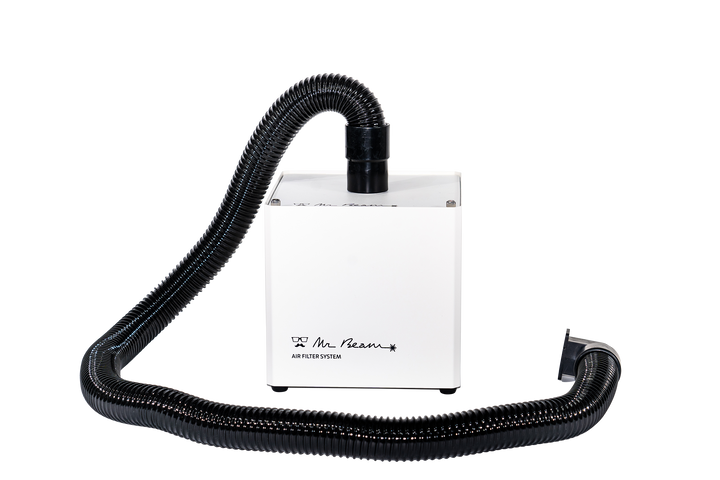Today we present you the result of Heike's journeyman carpenter exam. Our Mr. Beam actively supported you with the surface refinement. Heike was so nice and answered a few questions about your successful work.
When you see your journeyman's piece, the patterned surfaces immediately catch your eye. What's it all about?
The body of the sideboard is made of ash, the back panel and drawer bottoms are made of plywood, veneered with plum. Veneer is wood that can be up to a few mm thick, with which chipboard or plywood boards are glued to imitate a solid wood board. But of course you can also use the veneer, in my case it was 0.6 mm thick, to create a kind of jigsaw puzzle and then glue this pattern onto the panels. The technology is (of course without laser) already centuries old and was particularly in demand in the baroque period.
For the doors, I only used the light sapwood (the outer part of the trunk) and the darker core of the ash and the reddish brown of the plum.
And how did you use the Mr Beam?
You have to experiment a little with the settings for lasering the veneer, unfortunately there are no precise presets because every wood cuts differently. Eucalyptus veneer, for example, can hardly be lasered and chars enormously. To start with, I recommend fine-pored woods such as pear, apple, plum, birch, maple or beech for lasering, because the lasered parts are more stable in themselves. Filigree, lasered veneer parts made of ash, oak, chestnut or robinia break very easily during further processing at the points weakened by the coarse pores. You can stick everything back in place, but it's annoying when it comes to processing.
And if, like me, you laser a lot of veneer, you should give your laser head a little love sometimes and disassemble and clean it in good time.

Is there anything else that needs to be considered?
It is important when veneering that you veneer both the front and the back of your workpiece. Even if you may not see the back at all, because otherwise the plate can deform significantly. You also have to pay attention to the direction of growth of the wood and make sure that all parts that you then want to glue together have the same orientation.
Speaking of gluing. This works best by fixing the individual parts with adhesive tape. The adhesive tape can then be removed after gluing. From my own tiresome experience, I advise you to test how well the respective adhesive tape detaches from the wood beforehand. Otherwise, you sit there for hours and rub off the adhesive residue from your work.
You can glue the resulting "puzzle" with normal white glue, which you spread as thinly as possible on the carrier board.
And can this also be implemented without a carpentry workshop?
Of course, I had a professional veneer press available for gluing my veneers, but up to a certain size this can also be done relatively easily with screw clamps. So put a coated plate on top and bottom of the workpiece to distribute the pressure of the screw clamps evenly and apply as many clamps as possible with as much pressure as possible.

Now we've talked a lot about veneer, but not at all about the furniture as a whole! How did you come up with the idea?
To be honest, the idea of the veneer work came first, and then I came up with the surrounding furniture. It was clear to me that I wanted to have as much space as possible to let off steam with Mr Beam. And that's where the door fronts came in handy.
I was told from all sides that you have to be careful with patterns because you quickly get tired of them, so I decided on sliding doors that can be used on both sides. One side with a flat pattern, the other side plain. The doors are designed in such a way that they can be lifted upwards and then rotated around their own axis and reinstalled the other way round. I made three doors in total. So when I'm tired of a pattern, I can vary or turn both doors to the plain side and then have a very calm, classic piece of furniture.

The 50s and 60s were the inspiration for the design of the sideboard. And of course with feet! I think beautiful furniture needs feet. I don't like free-hanging, wall-mounted stuff. I make an exception for shelves and kitchen cabinets. ;)
What else could you do with Veneer and Mr. Beam?
As already indicated, large areas are a problem in the hobby sector. I can well imagine, for example, nameplates or doorplates, jewellery, game boards or parts for board games, wall decorations, caskets, etc. There are few limits to the imagination. It is also really nice to set lines on the wood that do not cut through completely, but only mark. This way you can easily set extra contours or internal drawings within the individual parts without the subsequent handicrafts becoming more complex.
You don't always have to produce flat surfaces. For example, you could also take a base made of light-coloured wood and then glue on accents made of darker veneer, which then protrude slightly plastically. That would be conceivable, for example, in the jewellery sector. (If the parts are small enough, then my advice about always having to veneer the front and back can be neglected.)
You can also shade the lasered pieces, so to speak, by heating sand in a pan and sticking the pieces in the sand with tweezers and waiting briefly. Placed correctly and removed in good time, this results in an almost three-dimensional effect.
I'm really excited to see if some veneer work will appear under #madewithmrbeam in the near future!
Many thanks to Heike for the interesting insight. You can admire more of her work on the Instagram account "grauzonenidee".




